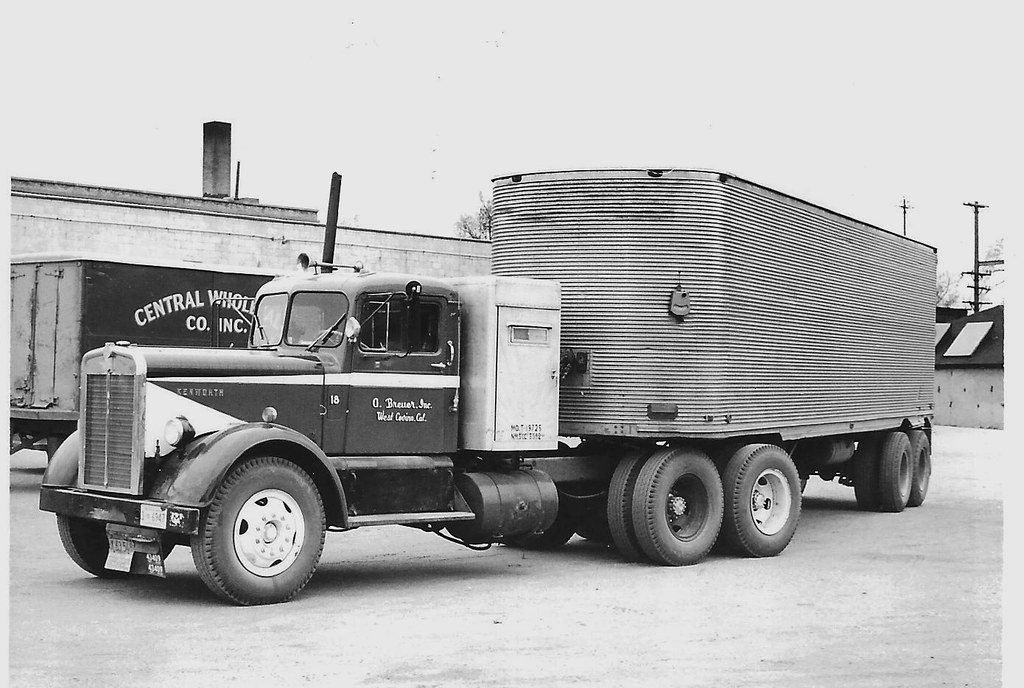
On This Page: Quick Navigation
History & Founder
August ("Gus") C. Fruehauf, a Detroit carriage builder, invented the first semi-trailer in **1914** for a local lumber merchant to haul a boat with a Ford Model T. This concept—detachable load transport—revolutionized commercial hauling.
The success of the design led to the formal incorporation of the **Fruehauf Trailer Company in 1918**. By the 1930s, Fruehauf was an industrial giant, pioneering modern highway freight transportation and supplying civilian and military markets worldwide. The company's headquarters were famously located in **Detroit, Michigan**.
The Golden Age (1940s - 1960s)
The post-WWII boom marked Fruehauf's **golden age of manufacturing**. With the interstate highway system expanding across the U.S., demand for high-capacity, durable trailers soared. Fruehauf dominated the market by perfecting the **Volume Van** (Hi-Cube) design and pioneering the use of **lightweight aluminum** construction to maximize payload and fuel efficiency. This era cemented Fruehauf as the industry's undisputed leader.
Key Innovations & Patents
Fruehauf didn't just build trailers; they engineered the systems that made modern trucking possible. They pioneered core technologies such as the **automatic fifth-wheel coupling** (making trailer hook-up and release faster and safer), **hydraulic dump trailers**, and early adoption of both **tanker trailers** and **containerization systems**.
The company filed hundreds of patents, including designs for **corrugated side panels** for structural strength and various proprietary **suspension systems**. These innovations fundamentally influenced global logistics and transport efficiency.
Models & Common Types
Fruehauf produced a vast catalog of trailers, often categorized by their primary build material (steel, aluminum) and application. The iconic look of the **Hi-Cube Volume Van** defined post-WWII freight.
| Type | Designation/Nickname | Typical Use |
|---|---|---|
| Dry Van | Volume Van, Hi-Cube | General, high-capacity freight |
| Tanker | Petroleum, Chemical Tanker | Fuel, asphalt, liquids, specialized chemicals |
| Dump | Hydraulic Dump Trailer | Construction, gravel, sand, demolition debris |
| Flatbed | Platform Trailer | Heavy equipment, steel, large structural components |
| Refrigerated Van | "Reefer" | Perishable goods, frozen food transport |
| Logger | Pole/Pulpwood Trailer | Timber and forestry industry hauling |
Identifying & Dating
VIN/data plates are usually found near the **kingpin** (the coupling plate) or on the front support **frame rails**. Pre-1981 trailers may have shorter, proprietary serial numbers; these older numbers often correspond to year and model in archived factory records. Post-1981 trailers use the standardized **17-digit VIN format**.
We recommend cross-referencing any numbers with official archives to confirm the trailer's original specifications and manufacture date.
Parts, Manuals & Repair
Finding original equipment manufacturer (OEM) parts can be challenging, but many components (axles, brakes, suspension systems) are often cross-compatible with parts from contemporaries like Eaton, Shuler, or Rockwell.
- **Manuals & Documentation:** Locate original **Service Manuals** and **Parts Catalogs** through collectors, historical societies, and dedicated online archives. These are crucial for accurate restoration.
- **Components:** Focus on sourcing replacement **Suspension & Axle parts** (often the most worn items) and ensuring all **brake systems** are modern and compliant.
- **VIN Plates:** Reproduction **VIN/Data plates** are available for cosmetic restoration, but ensure the original serial number is accurately transferred for historical integrity.
Restoration & Community
Restoration projects should prioritize structural integrity: focus on the **frame, suspension, and brakes** first. Authenticity is often determined by the accuracy of exterior lights, paint schemes (original company colors), and period-correct markings.
The vintage trucking community is a massive resource. Joining a dedicated online forum or a historical vehicle society is highly recommended for parts leads and technical advice.
Military & Defense Contracts
Fruehauf played a critical role in 20th-century defense. They were a major contractor during **World War II**, producing thousands of specialized trailers, including tank transporters, fuel bowsers, and mobile workshops. Their designs continued to serve through the Korean and Vietnam wars, including unique adaptations like **missile transporters** and **mobile communication units**.
These military models are particularly collectible due to their robust construction and historical significance.
The End of the U.S. Company
Following decades of successful operation, the U.S. Fruehauf corporation faced significant financial pressures and market shifts in the late 20th century. The company filed for **Chapter 11 bankruptcy** in the mid-1990s, and its domestic assets were liquidated. While the American manufacturing arm ceased operations, the **Fruehauf brand continues** under license in several international markets, particularly in Mexico and Europe.
Buying & Valuation
Values depend significantly on rarity, age, and condition. Early, pre-1940 models or specific military Fruehauf trailers are generally the most collectible and command higher prices. Always inspect critical safety systems (brakes, axles, coupling) and title documentation before completing a purchase.
FAQ: Commonly Asked Questions
Who founded Fruehauf, and when?
August C. Fruehauf, a Detroit carriage builder, invented the first semi-trailer in 1914. He formally incorporated the Fruehauf Trailer Company in **1918**.
Are Fruehauf trailers still produced today?
The original U.S. company closed in the 1990s following bankruptcy. However, the Fruehauf brand name continues under license by independent manufacturers in several international markets, including **Fruehauf de México** and operations in Europe and Australia.
How can I decode a Fruehauf VIN or serial number?
Pre-1981 trailers use proprietary serial numbers specific to the factory and year; decoding these often requires reference to archived factory catalogs. Post-1981 trailers use the standardized **17-digit VIN** system, which can be partially decoded using general vehicle VIN resources.
What is the most collectible Fruehauf trailer model?
Highly collectible models include the early aluminum tankers, the pre-war **Aero-Van** models, and military equipment like the specialized low-bed tank transporters, due to their historical significance and rarity.
Where is the VIN plate typically located on a Fruehauf trailer?
The data/VIN plate is most commonly found in two primary locations: either on the **front support assembly** (landing gear) or directly on the frame/bolster near the **kingpin** (the coupling plate).
Did Fruehauf invent the container shipping system?
While Fruehauf didn't invent the concept of containerization, the company was a crucial early pioneer and manufacturer of the **cargo containers** and the specialized trailers needed to haul them, significantly contributing to the modern intermodal shipping revolution.